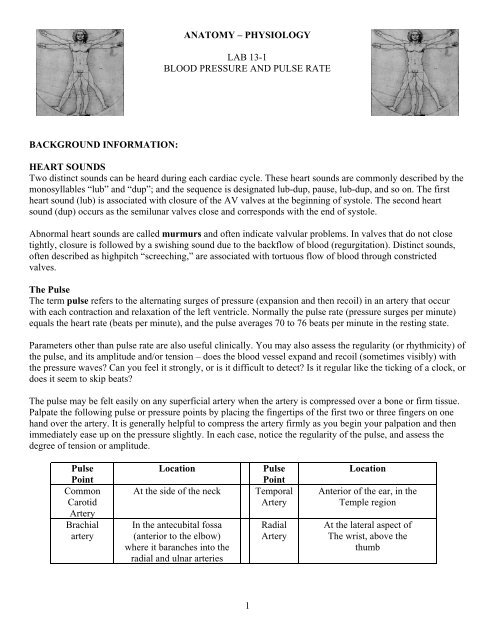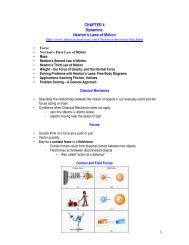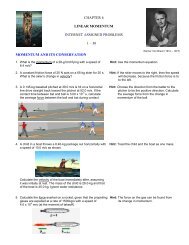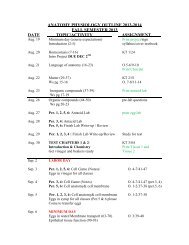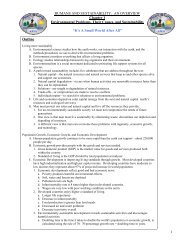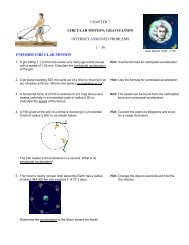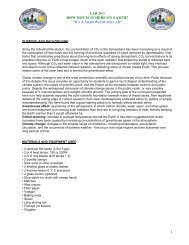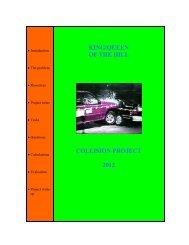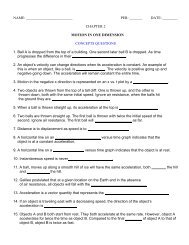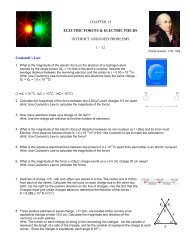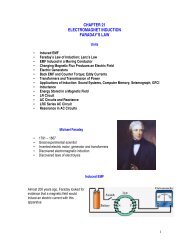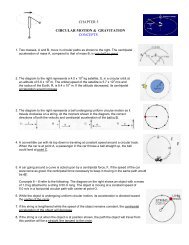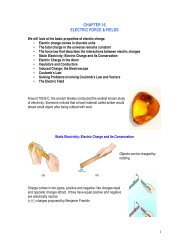Lab 13-1 Blood Pressure and Pulse Rate - Physics-matters.net
Lab 13-1 Blood Pressure and Pulse Rate - Physics-matters.net
Lab 13-1 Blood Pressure and Pulse Rate - Physics-matters.net
Create successful ePaper yourself
Turn your PDF publications into a flip-book with our unique Google optimized e-Paper software.
ANATOMY – PHYSIOLOGYLAB <strong>13</strong>-1BLOOD PRESSURE AND PULSE RATEBACKGROUND INFORMATION:HEART SOUNDSTwo distinct sounds can be heard during each cardiac cycle. These heart sounds are commonly described by themonosyllables “lub” <strong>and</strong> “dup”; <strong>and</strong> the sequence is designated lub-dup, pause, lub-dup, <strong>and</strong> so on. The firstheart sound (lub) is associated with closure of the AV valves at the beginning of systole. The second heartsound (dup) occurs as the semilunar valves close <strong>and</strong> corresponds with the end of systole.Abnormal heart sounds are called murmurs <strong>and</strong> often indicate valvular problems. In valves that do not closetightly, closure is followed by a swishing sound due to the backflow of blood (regurgitation). Distinct sounds,often described as highpitch “screeching,” are associated with tortuous flow of blood through constrictedvalves.The <strong>Pulse</strong>The term pulse refers to the alternating surges of pressure (expansion <strong>and</strong> then recoil) in an artery that occurwith each contraction <strong>and</strong> relaxation of the left ventricle. Normally the pulse rate (pressure surges per minute)equals the heart rate (beats per minute), <strong>and</strong> the pulse averages 70 to 76 beats per minute in the resting state.Parameters other than pulse rate are also useful clinically. You may also assess the regularity (or rhythmicity) ofthe pulse, <strong>and</strong> its amplitude <strong>and</strong>/or tension – does the blood vessel exp<strong>and</strong> <strong>and</strong> recoil (sometimes visibly) withthe pressure waves? Can you feel it strongly, or is it difficult to detect? Is it regular like the ticking of a clock, ordoes it seem to skip beats?The pulse may be felt easily on any superficial artery when the artery is compressed over a bone or firm tissue.Palpate the following pulse or pressure points by placing the fingertips of the first two or three fingers on oneh<strong>and</strong> over the artery. It is generally helpful to compress the artery firmly as you begin your palpation <strong>and</strong> thenimmediately ease up on the pressure slightly. In each case, notice the regularity of the pulse, <strong>and</strong> assess thedegree of tension or amplitude.<strong>Pulse</strong>PointCommonCarotidArteryBrachialarteryLocationAt the side of the neckIn the antecubital fossa(anterior to the elbow)where it baranches into theradial <strong>and</strong> ulnar arteries<strong>Pulse</strong>PointTemporalArteryRadialArteryLocationAnterior of the ear, in theTemple regionAt the lateral aspect ofThe wrist, above thethumb1
<strong>Blood</strong> pressure is defined as the pressure the blood exerts against any unit area of the blood vessel wall, <strong>and</strong> itis generally measured in the arteries. Because the heart alternately contracts <strong>and</strong> relaxes, the resulting rhythmicflow of blood into the arteries causes the blood pressure to rise <strong>and</strong> fall during each beat. Thus you must taketwo blood pressure readings: the systolic pressure, which is the pressure in the arteries at the peak ofventricular ejection, <strong>and</strong> the diastolic pressure, which reflects the pressure during ventricular relaxation. <strong>Blood</strong>pressures are reported in millimeters of mercury (mm Hg), with the systolic pressure appearing first; 120/80translates to 120 over 80, or a systolic pressure of 120 mm Hg <strong>and</strong> a diastolic pressure of 80 mm Hg. Normalblood pressure varies considerably from one person to another.The sphygmomanometer, commonly called a blood pressure cuff, is an instrument used to obtain bloodpressure readings. It consists of an inflatable cuff with an attached pressure gauge. The cuff is placed around thearm <strong>and</strong> inflated to a pressure higher than systolic pressure to occlude (stop) circulation to the forearm. As cuffpressure is gradually released, the examiner listens with a stethoscope for characteristic sounds called thesounds of Korotkoff, which indicate the resumption of blood flow into the forearm. The pressure at which thefirst soft tapping sounds can be detected is recorded as the systolic pressure. As the pressure is reduced further,blood flow becomes more turbulent, <strong>and</strong> the sounds become louder. As the pressure is reduced still further,below the diastolic pressure, the artery is no longer compressed; <strong>and</strong> flood flows freely <strong>and</strong> without turbulence.At this point, the sounds of Korotkoff can no longer be detected. The pressure at which the sounds disappear isrecorded as the diastolic pressure.OBJECTIVES:• Use a stethoscope to listen to the heart sounds <strong>and</strong> relate heart sounds to cardiac cycle events.• Determine a subject’s pulse.• Determine a subject’s blood pressure with a sphygmomanometer <strong>and</strong> relate systolic <strong>and</strong>diastolic pressures to events of the cardiac cycle.• Investigate the effects of exercise on blood pressure, pulse, <strong>and</strong> cardiovascular fitness.MATERIALS:• Stethoscope• Cotton swabs• Alcohol (used to clean earpieces of the stethoscope)• Stopwatch or other timing devicePROCEDURE:PART 1: BLOOD PRESSURE DETERMINATION1. Work in pairs to obtain blood pressure readings. Obtain a stethoscope, alcohol swabs, <strong>and</strong> asphygmomanometer. Clean the earpieces with the alcohol swabs, <strong>and</strong> check the cuff for the presence oftrapped air by compressing it against the lab table. (A partially inflated cuff will cause erroneousmeasurements.)2. The subject should sit in a comfortable position with one arm resting on the lab table (approximately atheart level if possible). Wrap the cuff around the subject’s arm, just above the elbow, with the inflatablearea on the medial arm surface. Secure the cuff by bringing the Velcro areas together.2
(a) The course of the brachial artery of the arm. Assume a blood pressure of 120/70.(b) The blood pressure cuff is wrapped snugly around the arm just above the elbow <strong>and</strong> inflated untilblood flow into the forearm is stopped <strong>and</strong> a brachial pulse cannot be felt or heard.(c) The pressure in the cuff is gradually reduced while the examiner listens carefully for sounds (orKorotkoff) in the brachial artery with a stethoscope. The pressure read as the first soft tappingsounds are heard (the first point at which a small amount of blood is spurting through theconstricted artery) is recorded as the systolic pressure.(d) As the pressure is reduced still further, the sounds become louder <strong>and</strong> more distinct, but when theartery is no longer restricted <strong>and</strong> blood flows freely, the sounds can no longer be heard. Thepressure at which the sounds disappear is routinely recorded as the diastolic pressure.3. Palpate the brachial pulse <strong>and</strong> place the diaphragm of the stethoscope over the pulse point.The cuff should not be kept inflated for more than 1 minute; so if have any trouble obtaining areading within this time, deflate the cuff, wait 1or 2 minutes, <strong>and</strong> try again.4. Inflate the cuff to approximately 160 mm Hg pressure, <strong>and</strong> slowly release the pressure valve. Watch thepressure gauge as you listen carefully for the first soft thudding sounds of the blood spurting through thepartially occluded artery. Mentally note this pressure (systolic pressure), <strong>and</strong> continue to release the cuffpressure. You will notice first <strong>and</strong> increase, then a muffling, of the sound. Note the pressure (diastolicpressure) at which the sound becomes muffled or disappears.5. Record the pressure readings below.Systolic pressure:_____________ Diastolic pressure:______________6. Define blood pressure.________________________________________________________________7. Identify the phase of the cardiac cycle to which each of the following apply:Systolic pressure:____________________________________________________________________Diastolic pressure:____________________________________________________________________3
8. What is the name of the instrument used to determine blood pressure? __________________________9. What are the sounds of Korotkoff?______________________________________________________10. What causes the systolic sound?________________________________________________________11. What causes the sound to disappear?____________________________________________________12. A person has a blood pressure of <strong>13</strong>5/87.a. What number represents the systolic pressure?___________________b. What number represents the diastolic pressure?__________________<strong>13</strong>. What effect (increase or decrease) does each of the following have on blood pressure?______ Increased diameter of the arterioles ______ Hemorrhage (blood loss)______ Increased blood viscosity______ Arteriosclerosis______ Increased cardiac output______ Increased pulse rate______________________________________________________________________________________PART 2: TEST OF FITNESSThe point scores on the following tests provide an evaluation of fitness based not only on cardiac musculardevelopment but also on the ability of the cardiovascular system to respond to sudden changes in dem<strong>and</strong>.CAUTION: Make sure you do NOT attempt this exercise if strenuous activity will aggravate a healthproblem.TEST 1: STANDING SYSTOLIC COMPARED WITH RECLINING SYSTOLICUse the sphygmomanometer to measure the change in systolic blood pressure from reclining to a st<strong>and</strong>ingposition.1. Put the blood pressure cuff on the arm of the subject but do not inflate the cuff.2. The subject should recline on the lab table for at least 5 minutes. At the end of this time, measure thesystolic <strong>and</strong> diastolic pressure. Record your measurements below.Reclining systolic pressure = __________ mm HgReclining diastolic pressure = __________ mm Hg3. Remain reclining for two minutes, then st<strong>and</strong> <strong>and</strong> immediately measure the systolic <strong>and</strong> diastolic pressure.Record your measurements below.St<strong>and</strong>ing systolic pressure = __________ mm HgSt<strong>and</strong>ing diastolic pressure = __________ mm Hg4. Subtract the st<strong>and</strong>ing systolic pressure from the reclining systolic pressure.Systolic pressure difference = __________ mm Hg4
5. Assign fitness points based on the data in the table below. Circle the number of fitness points assigned.Change (mm Hg) Fitness PointsRise of 8 or more 3Rise of 2 to 7 2No rise 1Fall of 2 to 5 0Fall of 6 or more –1Cardiac <strong>Rate</strong> <strong>and</strong> Physical FitnessDuring physical exertion, the cardiac rate (beats per minute) increases. This increase can be measured as anincrease in pulse rate. Although the maximum cardiac rate is generally the same in people of the same agegroup, those who are physically fit have a higher stroke volume (milliliters per beat) than more sedentaryindividuals. A person who is in poor physical condition, therefore, reaches his or her maximum cardiac rate at alower work level than a person of comparable age who is in better shape. Individuals who are in good physicalcondition can deliver more oxygen to their muscles (have a higher aerobic capacity) before reaching maximumcardiac rate than can those in poor condition.Thus, the physically fit have a slower increase in their cardiac rate with exercise <strong>and</strong> a faster return to theresting cardiac rate after exercise. Physical fitness, therefore, involves not only muscular development but alsothe ability of the cardiovascular system to respond to sudden changes in dem<strong>and</strong>.TEST 2: STANDING PULSE RATE1. The subject should st<strong>and</strong> at ease for 2 minutes after Test 1.2. After the 2 minutes, determine the subject’s pulse. Count the number of beats for 30 seconds <strong>and</strong> multiplyby 2. Record the pulse rate below:St<strong>and</strong>ing <strong>Pulse</strong> <strong>Rate</strong> = __________ bpm (beats per minute)3. Assign fitness points based on the data in the table below. Circle the number of fitness points assigned.TEST 3: RECLINING PULSE RATE<strong>Pulse</strong> <strong>Rate</strong> (bpm) Fitness Points60 – 70 371 – 80 381 – 90 291 – 100 1101 – 110 1111 – 120 0121 – <strong>13</strong>0 0<strong>13</strong>1 – 140 –11. The subject should recline for 5 minutes on the lab table. The subject should remain reclining inpreparation for TEST 4.2. Determine the subject’s pulse. Count the number of beats for 30 seconds <strong>and</strong> multiply by 2. Record thepulse rate below:Reclining <strong>Pulse</strong> <strong>Rate</strong> = __________ bpm (RPR)5
3. Assign fitness points based on the data in the table below. Circle the number of fitness points assigned.<strong>Pulse</strong> <strong>Rate</strong> (bpm) Fitness Points50 – 60 361 – 70 371 – 80 281 – 90 191 – 100 0101 – 110 –1TEST 4: BARORECEPTOR REFLEX (PULSE RATE INCREASE FORM RECLINING TOSTANDING)1. The reclining subject should now st<strong>and</strong> up.2. Immediately determine the subject’s pulse. Count the number of beats for 30 seconds <strong>and</strong> multiply by 2.Record the pulse rate below:<strong>Pulse</strong> rate immediately upon st<strong>and</strong>ing = __________ bpm (PRUS)4. Subtract the reclining pulse rate (RPR) from the pulse rate immediately upon st<strong>and</strong>ing (PRUS). Record thevalue below.Difference in pulse = __________ bpm5. Assign fitness points based on the data in the table below. Circle the number of fitness points assigned.TEST 5: Step Test – Endurance1. The subject should do the following:• Someone hold a chair.• Place one foot on the chair.• Step up with the other foot so that both feet are on the chair. Straighten your legs <strong>and</strong> back.• Step down with one foot.• Bring the other foot down.• Repeat the exercise 5 times with 3 seconds per cycle.2. Immediately after the completion of this exercise, measure <strong>and</strong> record the subject’s pulse for each timeinterval listed below.6
3. Observe the time that it takes for the subject’s pulse rate to return to approximately the level that wasrecorded in Test 2. Assign fitness points based on the data in the table below. Circle the number of fitnesspoints assigned.Time (seconds)Fitness Points0 – 30 431 – 60 361 – 90 291 – 120 1121 + 11 to 10 beats above0St<strong>and</strong>ing pulse rate11 to 30 beats above–1St<strong>and</strong>ing pulse rate4. Subtract the subject’s normal st<strong>and</strong>ing pulse rate (recorded in Test 2) from his/her pulse rate immediatelyafter exercise (the 0 to 15 second interval) to obtain pulse rate increase. Record the information below.<strong>Pulse</strong> rate increase = __________5. Assign fitness points based on the data in the table below. Circle the number of fitnesspoints assigned.6. Transfer the fitness points assigned for each test to the chart below <strong>and</strong> total the points.7
7. Assign a relative cardiac fitness level based on the data in the table below. Circle the fitness levelassigned.Total Score Relative Cardiac Fitness18 to 17 Excellent16 to 14 Goodto 8Fair7 or less PoorCONCLUSION1. Why do blood pressure <strong>and</strong> heart rate differ when measured in a reclining position <strong>and</strong> in a st<strong>and</strong>ingposition?__________________________________________________________________________________________________________________________________________________________________________________________________________________________________________________________________2. Why is high blood pressure a health concern?__________________________________________________________________________________________________________________________________________________________________________________________________________________________________________________________________3. Why must an athlete exercise harder or longer to achieve a maximum heart rate than a person who is not asphysically fit?__________________________________________________________________________________________________________________________________________________________________________________________________________________________________________________________________4. What did you learn from this activity?________________________________________________________________________________________________________________________________________________________________________________________________________________________________________________________________________________________________________________________________________________________8


